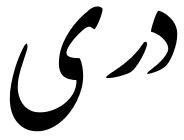Language/Dari/Grammar/Future-Tense
| ◀️ Past Tense — Previous Lesson | Next Lesson — Famous Dari Writers ▶️ |
Introduction
In Dari, the future tense is used to talk about actions or events that will happen after the present moment. In this lesson, you will learn how to form the future tense in Dari, its usage in sentences, and the difference between the simple and continuous future.
Consider exploring these related pages after completing this lesson: Adverbs & 0 to A1 Course.
Formation of the Future Tense
To form the future tense in Dari, you need to use the present tense base form of the verb and add specific suffixes. The suffixes used for the future tense are "-وه" and "-يم".
The suffix "-وه" is added to the end of the verb to indicate the simple future tense. It is used for the third person singular and plural subjects. The suffix "-يم" is added to the end of the verb to indicate the continuous future tense. It is used for all subjects.
Here is the table below showing the formation of the future tense:
| Person | Simple Future Suffix | Continuous Future Suffix |
|---|---|---|
| First Person Singular (I) | نمی + Verb + يم | Verb + "در حال" + می + "انجام" + Verb + يم |
| Second Person Singular (You) | نمی + Verb + وه | Verb + "در حال" + می + "انجام" + Verb + وه |
| Third Person Singular (He or She) | نمی + Verb + وه | Verb + "در حال" + می + "انجام" + Verb + وه |
| First Person Plural (We) | نمی + Verb + یم | Verb + "در حال" + می + "انجام" + Verb + يم |
| Second Person Plural (You) | نمی + Verb + وه | Verb + "در حال" + می + "انجام" + Verb + وه |
| Third Person Plural (They) | نمی + Verb + وه | Verb + "در حال" + می + "انجام" + Verb + وه |
For example, to say "I will eat" in Dari, you can say "نمیخورم" for simple future or "من در حال خوردن هستم" for continuous future.
Usage of the Future Tense
The future tense is used to talk about actions or events that will happen after the present moment. It is often used to make plans, arrangements, or predictions about the future.
Here are some examples of how the future tense can be used in Dari:
- بعد از شام، کتاب میخوانم.
(Baad az shaam, ketab mikhaanam.) After dinner, I will read a book.
- فردا صبح، او با دوستش قرار میگذارد.
(Farda sobh, u ba dustash gharar migzarad.) Tomorrow morning, he is meeting his friend.
- ما به هند خواهیم رفت.
(Maa be Hind khahim raft.) We will go to India.
- آیا فردا باران میبارد؟
(Aaya farda baaran mibaarad?) Will it rain tomorrow?
Simple vs Continuous Future
In Dari, the difference between the simple and continuous future is the duration of the action or event. The simple future tense is used for actions or events that will be completed in the future at a specific time, while the continuous future tense is used for actions or events that will be ongoing or in progress in the future.
Here are two examples below:
- ساعت ۷ بعد از ظهر، من خانه میروم. (Saat 7 baad az zohr, man khane miravam.)
At 7 o'clock in the afternoon, I will go home. (simple future - the action will be completed in the future at a specific time)
- فردا من در حال نوشتن کتاب خود هستم. (Farda man dar haal noosh-e-tan-e ketab-e khod hastam.)
Tomorrow, I will be writing my book. (continuous future - the action will be ongoing or in progress in the future)
Exercises
1. Translate the following sentences into Dari:
- They will read a book tomorrow.
- I will visit my family next week.
- Will you come to my birthday party?
- The train will arrive at the station at 10 pm.
2. Write ten sentences in Dari using the future tense.
Conclusion
In this lesson, you learned how to form the future tense in Dari, its usage in sentences, and the difference between the simple and continuous future. You also got some exercises to practice and improve your skills in using the future tense. Keep practicing, and soon you will feel confident in talking about future events or actions in Dari.
Now that you've completed this lesson, don't stop learning! Check out these related topics: Basic Prepositions & Give your Opinion.
Videos
Future tense in Farsi Dari language - آموزش زبان فارسی دری - زمان ...
Other Lessons
- How to Use Have
- Definite and Indefinite Articles
- Personal Pronouns
- Past Tense
- Give your Opinion
- Asking Questions
- Plurals
- Basic Prepositions
- Comparatives and Superlatives
- Describing People and Things
Sources
| ◀️ Past Tense — Previous Lesson | Next Lesson — Famous Dari Writers ▶️ |

